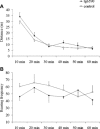Cognitive impairment in the Tg6590 transgenic rat model of Alzheimer's disease
- PMID: 19538474
- PMCID: PMC3829041
- DOI: 10.1111/j.1582-4934.2009.00809.x
Cognitive impairment in the Tg6590 transgenic rat model of Alzheimer's disease
Abstract
Recently, interest in the rat as an animal model of Alzheimer's disease (AD) has been growing. We have previously described the Tg6590 transgenic rat line expressing the amyloid precursor protein containing the Swedish AD mutation (K670M/N671L) that shows early stages of Abeta deposition, predominantly in cerebrovascular blood vessels, after 15 months of age. Here we show that by the age of 9 months, that is long before the appearance of Abeta deposits, the Tg6590 rats exhibit deficits in the Morris water maze spatial navigation task and altered spontaneous behaviour in the open-field test. The levels of soluble Abeta were elevated both in the hippocampus and cortex of transgenic animals. Magnetic resonance imaging showed no major changes in the brains of transgenic animals, although they tended to have enlarged lateral ventricles when compared to control animals. The Tg6590 transgenic rat line should prove a suitable model of early AD for advanced studies including serial cerebrospinal fluid sampling, electrophysiology, neuroimaging or complex behavioural testing.
Figures




References
-
- Almkvist O. Neuropsychological features of early Alzheimer’s disease: preclinical and clinical stages. Acta Neurol Scand Suppl. 1996;165:63–71. - PubMed
-
- Xie Z, Tanzi RE. Alzheimer’s disease and post-operative cognitive dysfunction. Exp Gerontol. 2006;41:346–59. - PubMed
-
- Selkoe DJ. Alzheimer’s disease: genes, proteins, and therapy. Physiol Rev. 2001;81:741–66. - PubMed
-
- Abbott A. Laboratory animals: the Renaissance rat. Nature. 2004;428:464–6. - PubMed
Publication types
MeSH terms
Substances
LinkOut - more resources
Full Text Sources
Medical

